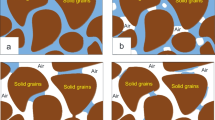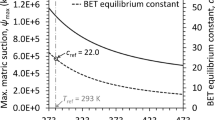Abstract
An analytical solution of Laplace’s equation is obtained for the flow of water in the tension-saturated zone of a “Green and Ampt” soil, subject to uniform vertical infiltration from above, around an axisymmetric cavity of critical shape that just excludes water. The solution is obtained by converting a line-source potential in a plane seepage flow into a line source in an axisymmetric flow (the Polubarinova-Kochina solution) using Pologii’s integral transform combined with a unit-gradient potential for downward seepage flow. The analysis shows that both the cavity surface and the capillary fringe boundary are paraboloids between which is sandwiched a tension-saturated region. The critical cavity obtained for the Green and Ampt soil and Philip’s paraboloidal cavity obtained for a “Gardner” soil allow the estimates of the soil parameters used in the two soil models to be related.
Similar content being viewed by others
References
Philip JR, Knight JH, Waechter RT (1989a) Unsaturated seepage and subterranean holes: conspectus, and exclusion problem for circular cylindrical cavities. Water Resour Res 25: 16–28. doi:10.1029/WR025i001p00016
Philip JR, Knight JH, Waechter RT (1989b) The seepage exclusion problem for parabolic and paraboloidal cavities. Water Resour Res 25: 605–618. doi:10.1029/WR025i004p00605
Gardner WR (1958) Some steady-state solutions of the unsaturated moisture flow equation with application to evaporation from a water table. Soil Sci 85: 228–232
Green WH, Ampt GA (1911) Studies in soil physics. 1. The flow of water and air through soils. J Agric Sci 4: 1–24
Polubarinova-Kochina PYa (1977) Theory of ground-water movement. Nauka, Moscow (in Russian)
Kliot-Dashinskii MI (1961) Seepage into a small borehole in a confined aquifer with a highly permeable substratum. Izvestiya Akademii Nauk SSSR. Otdelenie Tekhnicheskikh Nauk N5: 193–196 (in Russian)
Millionshikov MD (1950) Hydromechanical analysis of “chemical tamponage” of wells. Ingenernyj Sbornik VII: VII: 49–54 (in Russian)
Pologii GN (1965) Generalisation of the theory of analytic functions of complex variable. Kiev University Press, Kiev (in Russian)
Polubarinova-Kochina PYa (1965) Approximate solution of some 3-D problems of groundwater movement. Izv AN SSSR Mekh N 4: 183–185 (in Russian)
Polubarinova-Kochina PYa (1969) On the problem of obtaining axisymmetric flows from plane ones. Fluid Dyn 4(3): 133–136 (in Russian)
Razumova-Sretenskaya VN (1957) Some axisymmetric flows of gas in coal beds. Izv AN SSSR OTN N6: 119–125 (in Russian)
Fabrikant VI (1991) Mixed boundary value problems of potential theory and their applications in engineering. Kluwer, Dordrecht
Grinberg GA (1948) Selected topics in mathematical theory of electric and magnetic phenomena. AN SSSR, Moscow-Leningrad (in Russian)
Saulit VP (1966) 3-D field distribution in magnetospectrometers and the shape of magnetic tips. Proc Leningrad Univ 16: 30–50 (in Russian)
Terentiev AG, Zhitnikov VP (2006) Stationary two-dimensional inviscid flow with flexible boundaries including the effect of surface tension. J Eng Math 55(1–4): 111–126. doi:10.1007/s10665-005-9021-2
Steward DR (2002) A vector potential and exact flux through surfaces using Lagrange and Stokes stream functions. Proc R Soc Lond A 458(2018): 489–509
Kacimov AR (2008a) Optimization and analysis of advective travel times beneath hydraulic structures. J Hydraul Eng ASCE 134(9): 1311–1317. doi:10.1061/(ASCE)0733-9429(2008)134:9(1311)
Kacimov AR (2008b) On the Maas problem of seawater intrusion combated by infiltration. J Hydrol 358: 354–358. doi:10.1016/j.jhydrol.2008.06.015
Raats PAC (1971) Steady infiltration from point sources, cavities, and basins. Soil Sci Soc Am Proc 35: 689–694
Deans SR (1996) Radon and Abel transforms. In: Poularikas AD (eds) The transforms and applications handbook. Electrical engineering handbook series. CRC Press, Boca Raton
Youngs EG (2002) The seepage exclusion problem for tunnel cavities in the saturated capillary fringe. In: Environmental mechanics: water, mass and energy transfer in the biosphere. American Geophysical University. Geophysical Monograph 129, pp. 71–78
Youngs EG, Kacimov AR, Obnosov YuV (2004) Water exclusion from tunnel cavities located in the saturated capillary fringe with uniform precipitation flowing to a water-bearing substratum. Adv Water Resour 27: 237–243
Youngs EG, Kacimov AR (2007) Critical tunnel cavities for water exclusion in “Green and Ampt” and “Gardner” soils. Water Resour Res 43: W05501. doi:10.1029/2006WR004907
White I, Sully MJ (1987) Macroscopic and microscopic capillary length and time scales from field infiltration. Water Resour Res 23: 1514–1522
Ivantsov GP (1947) Temperature field around a spherical, cylindrical, and needle-shaped crystal, growing in a pre-cooled melt. DAN SSSR 58: 567–569 (in Russian)
Author information
Authors and Affiliations
Corresponding author
Rights and permissions
About this article
Cite this article
Kacimov, A.R., Youngs, E.G. Axisymmetric critical cavities for water exclusion in “Green and Ampt” soils: use of Pologii’s integral transform. J Eng Math 64, 105–112 (2009). https://doi.org/10.1007/s10665-008-9264-9
Received:
Accepted:
Published:
Issue Date:
DOI: https://doi.org/10.1007/s10665-008-9264-9




